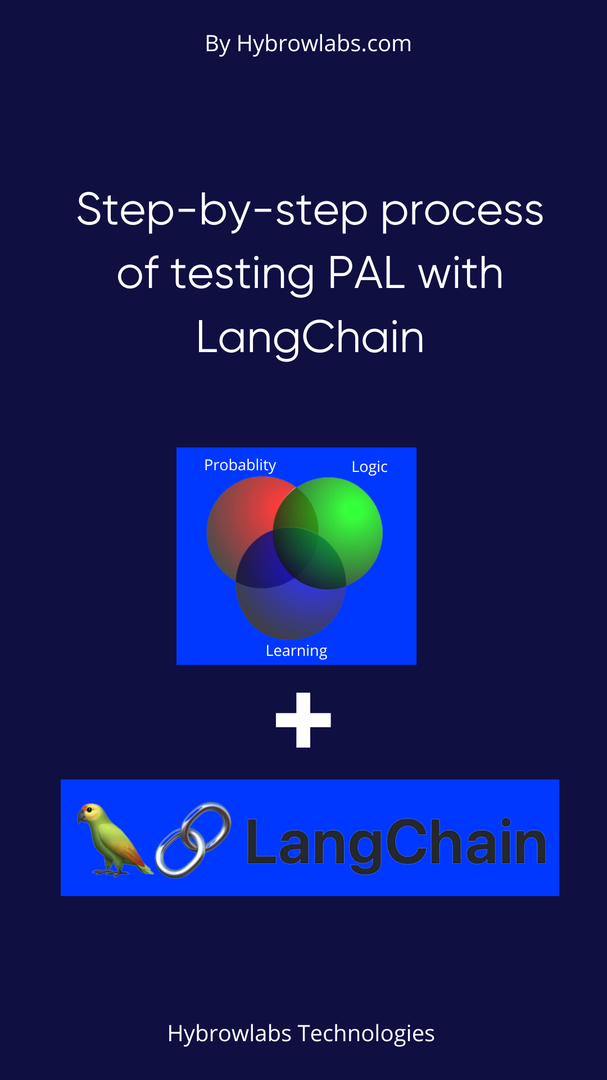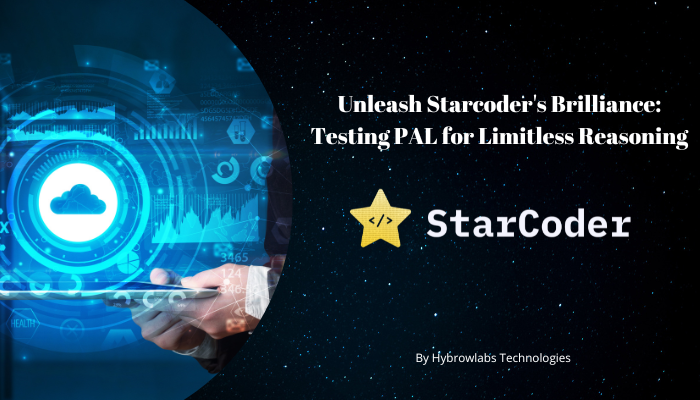
Discover the untapped potential of Starcoder, a tool with advanced reasoning capabilities. To unlock its true power, we delve into Probabilistic Argumentation Logic (PAL) testing. Join us on a quest to revolutionize decision-making as we explore the steps involved in unleashing Starcoder's brilliance through PAL. Get ready for a captivating journey into the future of intelligent reasoning.
Testing Probabilistic Argumentation Logic (PAL) is an important step toward fully utilizing Starcoder's capabilities. PAL testing is essential because it lets us fully exploit Starcoder's sophisticated reasoning capabilities. By subjecting Starcoder to rigorous PAL testing, we may be able to increase its ability to deal with uncertainty, ambiguity, and complex decision-making situations. This testing method allows us to push the frontiers of intelligent reasoning and allows Starcoder to solve complicated issues with unparalleled precision and efficiency. PAL testing is the key to unlocking Starcoder's true potential, paving the way for game-changing breakthroughs in a wide range of industries that require advanced reasoning.
Understanding Starcoder & Its Role In Advanced Reasoning:
Starcoder is an innovative tool that embodies advanced reasoning capabilities. It combines sophisticated algorithms and cutting-edge technologies to tackle complex problems and decision-making processes. At its core, Starcoder is designed to analyze vast amounts of data, identify patterns, make inferences, and generate logical conclusions.
Starcoder's role in advanced reasoning is essential. It outperforms standard rule-based systems by using machine learning, probabilistic reasoning, and argumentation logic. These aspects enable Starcoder to handle uncertainty, ambiguity, and contradicting information, resulting in a more sophisticated and robust reasoning approach.
Introducing PAL (Probabilistic Argumentation Logic):

PAL, which stands for Probabilistic Argumentation Logic, is a powerful paradigm for dealing with uncertainty and ambiguity in reasoning processes that integrates probability theory and argumentation logic. It provides a formal framework for representing and assessing arguments in the presence of uncertainty, making it an important tool for advanced reasoning and decision-making.
PAL expands standard argumentation logic by introducing probabilistic aspects, allowing for the modeling of ambiguous and contradictory data. It allows for the evaluation of the strength and believability of arguments using probabilities, allowing for more nuanced and context-aware reasoning.
PAL has numerous applications in fields such as artificial intelligence, data analytics, decision support systems, and expert systems. It is especially useful in sectors characterized by ambiguity, such as medical diagnosis, risk assessment, and financial forecasting.
The Benefits Of PAL In Enabling Advanced Reasoning & Decision-Making:

1. Handling Uncertainty:
PAL integrates probabilistic reasoning with argumentation logic, allowing for the representation and evaluation of arguments under uncertainty. It provides a formal framework to handle and reason with uncertain and conflicting information, essential in real-world scenarios where uncertainty is prevalent.
2. Capturing Complex Relationships:
PAL enables the modeling of complex relationships among different arguments, evidence, and hypotheses. It allows for the representation of dependencies, conflicting evidence, and probabilistic impacts, providing a more comprehensive and nuanced understanding of the problem at hand.
3. Weighted Evaluation of Arguments:
PAL assigns probabilistic weights to arguments based on the available evidence, enabling a quantitative assessment of their strengths and credibility. This weighted evaluation allows for a more nuanced analysis of arguments and their impact on decision-making, considering both logical consistency and the degree of support provided.
4. Adaptive Reasoning:
PAL can adapt its reasoning and decision-making processes based on updated evidence or changing contexts. It allows for dynamic updates to the probabilistic weights of arguments, incorporating new information and adjusting the conclusions accordingly. This adaptability enhances the responsiveness and flexibility of reasoning systems.
Reasoning With Starcoder Demo:

A conceptual demo where Starcoder is utilized for financial investment decision-making.
# Import the Starcoder libraryimport Starcoder# Initialize Starcoderstarcoder = Starcoder.Starcoder()# Define investment factors and corresponding weightsinvestment_factors = {'Profitability': 0.5,'Market Trend': 0.3,'Company Reputation': 0.2}# Define investment options and their ratingsinvestment_options = {'Option A': {'Profitability': 0.8,'Market Trend': 0.6,'Company Reputation': 0.9},'Option B': {'Profitability': 0.7,'Market Trend': 0.5,'Company Reputation': 0.8},'Option C': {'Profitability': 0.6,'Market Trend': 0.7,'Company Reputation': 0.6}}# Perform reasoning with Starcoderresult = starcoder.reason(investment_factors, investment_options)# Retrieve the recommended investment optionrecommended_option = result['RecommendedOption']# Print the recommended investment optionprint("Recommended Option:", recommended_option)
In this demo, we initialize Starcoder and define the investment factors along with their corresponding weights. We also create a set of investment options with their ratings for each factor.
We then call the ‘reason’ method of Starcoder, passing the investment factors and options as parameters.
The result of the reasoning process is stored in the ‘result’ variable. We can retrieve the recommended investment option from the ‘RecommendedOption’ key of the result.
Finally, we print the recommended investment option based on the reasoning performed by Starcoder.
Testing PAL for Advanced Reasoning Capabilities with LangChain:

To test PAL (Probabilistic Argumentation Logic) for advanced reasoning capabilities in conjunction with LangChain for natural language processing (NLP), you can follow these steps:
1. Define Testing Objectives:
Clearly define the objectives of testing PAL and LangChain together to evaluate their combined performance in advanced reasoning and NLP tasks. Determine the specific reasoning and NLP scenarios you want to assess, such as legal argumentation, decision-making, sentiment analysis, or entity recognition.
2. Create Test Scenarios:
Develop a set of test scenarios that involve complex reasoning tasks along with NLP components. Each scenario should include a description of the problem, available evidence or arguments, and input text or query for NLP processing.
3. Implement Testing Integration:
Use a programming language of your choice and the APIs or libraries provided by PAL and LangChain to implement the testing integration. Construct the argumentation graphs in PAL, assign weights to arguments, and utilize LangChain for NLP processing of the input text.
4. Example (Python using PAL and LangChain APIs):
import palimport langchain# Initialize PAL Frameworkpal_framework = pal.initialize()# Initialize LangChain NLP Systemlangchain_system = langchain.initialize()# Create an argumentation graph in PALgraph = pal_framework.create_argumentation_graph()# Add arguments and evidence to the graphargument1 = graph.add_argument("This is argument 1.")argument2 = graph.add_argument("This is argument 2.")graph.add_evidence(argument1, "Evidence 1")graph.add_evidence(argument2, "Evidence 2")# Assign weights to the argumentsgraph.set_argument_weight(argument1, 0.8)graph.set_argument_weight(argument2, 0.6)# Get input text for NLP processinginput_text = "Can you provide insights on the legal implications of this case?"# Perform NLP processing using LangChainnlp_output = langchain_system.process(input_text)# Perform PAL reasoning on the argumentation graphresult = pal_framework.reason(graph)# Retrieve the overall support level for each argument from PALfor argument in graph.arguments:support = result.get_argument_support(argument)print(f"Argument: {argument}")print(f"Overall Support: {support}")print("-----------------------")# Retrieve conclusions based on PAL evaluationconclusions = result.get_conclusions()print("Conclusions:")for conclusion in conclusions:print(conclusion)# Analyze NLP output from LangChainsentiment = nlp_output.sentiment_analysis()entities = nlp_output.extract_entities()# Further analysis and reporting...
5. Evaluate and Analyze Results:
Compare the real PAL reasoning results and conclusions to the expected outcomes for each test situation. In advanced reasoning and NLP tasks, evaluate the correctness, consistency, and effectiveness of the combined PAL and LangChain systems. Examine any discrepancies or restrictions that were discovered throughout testing.
6. Report Findings:
- Prepare a comprehensive report documenting the PAL and LangChain testing process, including the test scenarios, results, and analysis. Summarize the performance of the combined system, highlighting the strengths, weaknesses, and overall effectiveness in advanced reasoning and NLP tasks. Provide insights and recommendations for improvements, if necessary, to enhance the capabilities of the integrated PAL and LangChain system.
- Consult the documentation and guidelines provided by the PAL framework and LangChain to ensure accurate integration and usage during the testing process.
Conclusion:
By harnessing the combined power of PAL and LangChain, we can significantly enhance our problem-solving capabilities, make well-informed decisions, and extract valuable insights from textual data. This integration of advanced reasoning and NLP technologies creates exciting opportunities across various domains, such as law, medicine, finance, and more.
In conclusion, the testing of PAL for advanced reasoning capabilities with LangChain exemplifies the potential synergy between these technologies and lays the groundwork for their future advancements and real-world applications. If you're interested in exploring the development services offered by Hybrowlabs, please follow this link: Hybrowlabs Development Services.
FAQ:
1. What is PAL?
PAL stands for Probabilistic Argumentation Logic, a framework for probabilistic reasoning and decision-making based on representing arguments and their relationships.
2. How can PAL be tested?
PAL can be tested by creating test scenarios, constructing argumentation graphs, assigning weights to arguments, and comparing actual outcomes with expected results.
3. Why is testing PAL important?
Testing PAL is important to evaluate its performance and effectiveness in complex reasoning tasks, such as legal argumentation, decision-making, and problem-solving.
4. Why is testing LangChain important?
Testing LangChain is important to assess its accuracy, reliability, and effectiveness in performing NLP tasks like entity recognition, sentiment analysis, and language understanding.
5. What are the benefits of testing PAL and LangChain together?
Testing PAL and LangChain together allows for exploring the combined potential of advanced reasoning capabilities and NLP functionalities, leading to more comprehensive insights and decision-making.






a3dc85.jpg)

.jpg)
fd8f11.png)

.jpg)
.jpg)